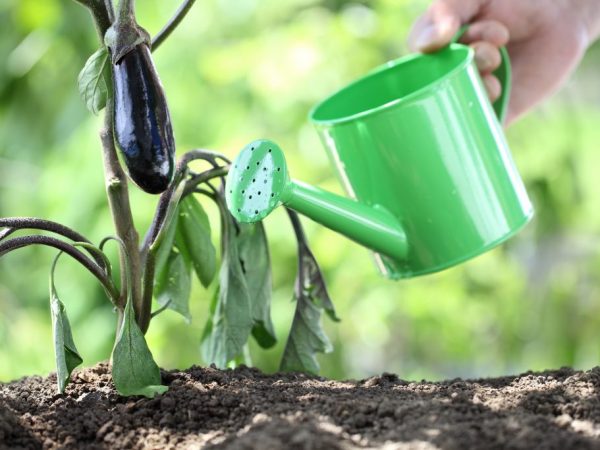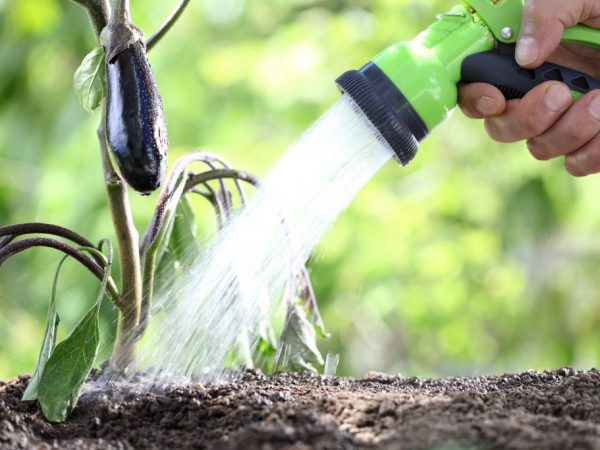How often to water the eggplant
It is not so difficult to get a good eggplant harvest if you know the planting rules and know how often to water the eggplant in a greenhouse growing method.

How often to water the eggplant
General care rules
These vegetables are heat-loving exotic plants that require careful cultivation.
The choice of soil, top dressing, transplanting and adherence to a certain temperature and humidity is the key to success in obtaining a healthy and large harvest. Watering eggplant seedlings deserves special attention. The composition of the water, its temperature, is as important as the frequency of watering.
Irrigation water
Watering eggplant seedlings is best done with soft, melt, rain or boiled water. If the volume of watering is large, then not boiling is allowed, but the weathering of chlorine from open containers with water.
To improve the quality of seedlings or early ripening of fruits, fertilizers are added to the water or insisted on the shell of chicken eggs, which saturates it with calcium and potassium. To properly prepare water on eggshells, you should take:
- 5 l of separated water
- crushed shell from 10 eggs
- a container for infusion (choose such that there is no oxidation process).
The crushed shell is poured into a container with settled, necessarily warm water. Stirred and left for 3-4 days. After that, it is filtered and used for watering.
If it is not possible to use the shell, it can be replaced with "drunk" tea leaves or tea bags.
Watering eggplants in a greenhouse with water infused with birch ash is carried out not only for nutrition, but also for disinfecting the soil, neutralizing nitrates in it.
Watering seedlings
To grow healthy and large vegetables, you need to know how often to water eggplant seedlings in a polycarbonate greenhouse. Watering should be carried out from the beginning of the soil preparation period. It goes through the process of disinfection with a hot solution of potassium permanganate. All selected seeds are soaked in a stimulating solution. Sowing is done after 24 hours in containers or in open ground. The seeds are sprinkled with soil and sprayed with settled and enriched water.
Before planting, water each m² of 5 l. water. As soon as the moisture is absorbed, the seedlings are planted, and the earth around is mulched with peat, sawdust or tree bark. If the planting was done in the morning, then the next hydration is carried out in the evening.
After a few 3-5 days, the soil dries out, the first shoots appear. Carefully, so as not to damage the roots, the earth is loosened. This will allow oxygen to penetrate the root system and saturate it with air. After loosening, the next watering of the eggplant seedlings is carried out.
These vegetables do not tolerate excess moisture. Erosion of the soil and exposure of seeds is not allowed, they will immediately die. To prevent this from happening, use a syringe without a needle, a teaspoon or a spray bottle for the first watering.
Air humidity in the greenhouse is maintained at 65-70%.Proper watering of seedlings in the morning helps to protect plants from sunburn on the leaves, after moisture gets on them. She manages to evaporate before the onset of heat. The soil around is necessarily loosened and mulched, but only in the evening. After the onset of stable heat, the greenhouse is ventilated.

Don't water the eggplant often.
How often to water eggplant seedlings in the greenhouse:
- the first time during landing;
- the second time after 5 days;
- next watering every 7 days.
Proper watering protects eggplants from drought, disease and death. To replenish moisture, the soil is spilled 20 cm deep with each watering, which is carried out every 7-10 days. The frequency is regulated by weather conditions. If it gets colder or the weather is cloudy, the amount of watering is reduced.
Watering during flowering
During the flowering of eggplants, the water regime is combined with the fertilization regime. Organic and mineral additives are used for feeding. For watering during this period, the following rules and sequence of actions are observed:
- water only with warm water;
- use only settled water without chlorine;
- feed along with watering;
- obligatory mulching after moisture absorption.
Watering the seedlings is carried out directly at the root. Drip irrigation system is the perfect solution to the problem. The water temperature should be 23-25 ° C. If the water is colder, the plant will lose color. Nutrients are applied immediately after all the moisture has been absorbed, right under the root. If drip irrigation is used, fertilizers are added to the water to shed the soil.
Mulching and loosening is carried out weekly, in the evening, to avoid drying out the soil.
There is a unique method to preserve soil moisture. It is loosening the soil 5 cm deep, 11-12 hours after watering.
Watering during fruit ripening
During fruiting, the need for watering doubles. It is done 1 p. in 3 days, 3-4 liters for each bush, at the rate of 15 liters per 1 m². In this case, the ovary will firmly hold on to the stem and will not fall off, the fruits will ripen on time and will be large in size.
Watering frequency increases during hot summer weather. Be sure to ventilate the greenhouse regularly to avoid root rot and fungal infections.
Common watering errors
For these vegetables, it is important to keep the temperature and airing at the same time. This is due to the thermophilicity of the plant. A common mistake is a poorly ventilated greenhouse and high air humidity in it.
To control the parameters, 2 thermometers are installed: in the middle and under the roof of the greenhouse. The vegetable culture will die at temperatures above 40 ° C and below 13 ° C. Pollination and fruit setting will stop. Aphids will multiply.
The next common cultivation mistake in a greenhouse is drafts in it. Plants begin to ache, their growth slows down. To avoid this, ventilation is done correctly: the transom sashes open on one side. If this does not help to reduce the temperature, then watering the rows and paths is carried out.
Conclusion
Demanding exotic vegetables will delight you with a rich harvest if you fulfill all the watering conditions during planting, flowering and fruiting. Only 12-13 waterings will be required per season.


